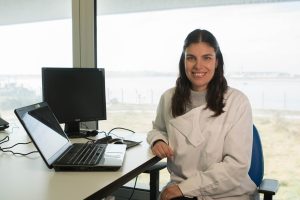Poster prizes at ‘Plasticity across scales: from molecules to phenotypes’
The EMBO | EMBL Symposium ‘Plasticity across scales: from molecules to phenotypes’ brought together a diverse group of scientists to discuss phenotypic, developmental, and transgenerational plasticity from a wide range of disciplines and perspectives. Ample opportunities were available for discussions, networking, and meeting new people. The poster sessions showcased all of the great research at the meeting and we are happy to present here the five poster prize winners.
AMPK-mediated regulation of germline quiescence and integrity through neuron-to-germ line communication during the dauer stage of Caenorhabditis elegans
Presenter: Christopher Wong

Abstract:
Stem cells have unique features that make them interesting from biological and clinical perspectives. Understanding how developmental potential is partitioned following their division and how one cell retains the ability to self-renew is exciting. But despite these cell division particularities, most stem cells don’t like to divide at all. To understand how genetic pathways control stem cell quiescence, we use the model organism Caenorhabditis elegans to investigate potential mechanisms that regulate germline cell cycle decisions. In adverse conditions, C. elegans enter a stress-resistant stage called the dauer stage that is geared towards long-term survival. We previously found that the LKB1/AMPK signalling axis is important for not only the survival of the animal in the dauer stage but also the recovery of the dauer larva into a reproductive adult. In replete conditions, mutants that lack all AMPK signalling develop like wild type animals. However, when these mutants pass through the dauer stage, they emerge completely sterile. Mechanistic details of how AMPK regulates the germ line are unknown.
We show that AMPK impinges on a RabGAP pathway in the neurons to ensure that the germline stem cells become quiescent in order to preserve reproductive integrity during periods of energetic stress. In adverse conditions, AMPK negatively regulates the activity of a RabGAP TBC-7 to ensure that the Rab GTPase RAB-7 remains in its GTP-bound active form in the neurons. We hypothesize that microRNAs are packaged into late endosomes in the neurons through the activity of RAB-7 and the dsRNA transport protein SID-5, generating extracellular vesicles that are internalized into the germ line, mediated through the kinase activity of non-receptor tyrosine kinase SID-3. Our findings reveal a novel role for AMPK in directing small RNA trafficking into neuronal vesicles to coordinate changes in the germ line that are critical for maintaining germ cell integrity and reproductive fitness through a period of developmental quiescence. The genes involved in these events may provide invaluable insight at numerous levels from how cells decide to divide or arrest in response to their environment, to increasing RNA internalization efficiency for many biomedical applications, including the development of increasingly efficient RNA vaccines.
Due to the confidentiality of the unpublished data, we cannot share the poster.
Dissecting the genetic architecture underlying mouth dimorphism in Pristionchus pacificus identifies cis-regulatory variation in a supergene locus
Presenter: Mohannad Dardiry

Abstract:
Phenotypic plasticity describes the property of a genotype to respond to environmental variation by producing distinct phenotypes. In Pristionchus pacificus, the mouth form is developmentally plastic, resulting in two alternative mouth forms: the eurystomatous (Eu) predatory form has two teeth, whereas the alternative bacteriovorus stenostomatous (St) form has a single tooth. The switch between the two forms is environmentally sensitive, and a previous forward genetic approach showed a key switch function for the sulfatase-coding gene eud-1, mutations in which result in all-St worms. In this study, we used P. pacificus natural isolates with different Eu/St ratios to generate Recombinant Inbred Lines (RIL) and performed Quantitative Trait Locus (QTL) analysis to dissect the genetic architecture underlying mouth dimorphism. Our result showed the involvement of one major locus on the X chromosome, spanning a recently described multi‐gene locus containing eud-1, its paralog, and two more genes encoding α-N-acetylglucosaminidases (nag), all of which were shown to be involved in mouth form regulation. RNA-seq analysis of parental strains revealed 40% higher expression of eud-1 in the high Eu parental strain, and CRISPR-Cas9 mutants of the two sulfatases paralogous in the high Eu parental strain showed a complete switch to the St form. With the absence of non-synonymous substitutions in eud-1 between the parental lines, we used CRISPR-Cas9 technology to perform variant swapping in the eud-1 regulatory region to define potential causative SNPs. Our experimental analysis identified variations in different cis-regulatory components of eud-1. Copy number differences in a potential Forkhead transcription factor binding site within the promoter/enhancer region, besides a SNP in the eud-1 first intron between the parental lines, caused differences in mouth-form ratios phenotype. Mutant lines showed an additive effect of these cis-regulatory elements, with a systematic change in the mouth-form phenotype and downregulation of eud-1 expression. Currently, we are using CRISPR-Cas9 technology to examine the potential involvement of various Forkhead genes in controlling eud-1 expression, while also expanding our analysis to test variations in the causative region within 30 more P. pacificus natural isolates.
Within and transgenerational plastic responses of congeneric marine annelids under ocean warming and copper pollution
Presenter: Diana Madeira

Abstract:
Ocean warming and metal pollution are known to affect the metabolism of ectotherms, inducing changes in cellular functioning, whole-organism performance and fitness. However, little is known about how within- (WGP) and trans-generational plasticity (TGP) operates in response to complex environmental changes in closely related species. This study aimed to uncover the WGP and TGP of fitness-related traits as well as the underlying molecular mechanisms (i.e. proteome adjustments), in a common (Ophryotrocha japonica) and a rare (Ophryotrocha adherens) species of congeneric marine annelids, exposed to global and local change drivers. Specifically, we first compared the WGP of the two species exposed to four scenarios (i) control (C) (24°C, no pollution), (ii) ocean warming (OW) (+3°C), (iii) copper pollution (Cu) (10 µg mL-1), (iv) copper pollution and ocean warming (Cu & OW) (10 µg mL-1, +3°C). Species differed in their ability to respond to ocean warming and copper pollution conditions within-generation, the rare species (O. adherens) showing significant decreases in fecundity and successful breeding under OW, but especially under Cu & OW. The common species (O. japonica) was able to keep breeding and fecundity across all scenarios. At the proteome level, no major changes were detected in O. japonica across treatments, while O. adherens showed some adjustments in cellular stress response pathways. We then investigated the rare species’ (O. adherens) capacity for TGP (F1 to F3 generations) under the effect of ocean warming, testing its ability to buffer environmental changes throughout generations. O. adherens was able to thrive across generations under higher-than-control temperatures despite a reduction in fitness compared to the control scenario. Moreover, fitness-related traits were less plastic under the ocean warming scenario, and therefore proteomics analyses are currently being completed to detect metabolic changes and possible energetic trade-offs throughout generations. Overall, we found that congeneric species have markedly different sensitivities to future global and local changes and that more sensitive species may persist over consecutive generations possibly through a re-allocation of the cellular energy budget.
AMPK regulates small RNA allocation and homeostasis to promote the transmission of a pro-quiescence signal from the soma to the germ line in the context of energetic stress
Presenter: Elena Jurczak

Abstract:
The ability of an organism to quickly and reversibly enact cellular and systemic changes in response to signals from its environment is one of the key characteristics defining survival and reproductive fitness. For many organisms, the energy sensor and master metabolic regulator AMPK maintains the homeostatic control of cellular energy balance by perceiving changes in resource availability and generating context-appropriate responses to preserve cellular integrity. Caenorhabditis elegans larvae exposed to various energetic stressors enter a stage of developmental quiescence (termed “dauer”) which allows them to preserve cellular integrity in the absence of appropriate growth conditions. Animals lacking AMPK signaling, however, exhibit highly penetrant post-dauer germline defects, aberrant gene expression changes, and severely downregulated microRNA expression levels.
In this study, we identify a novel pathway where AMPK cell non-autonomously regulates the quiescence of germline stem cells during periods of metabolic duress by directly altering the dynamics of small RNA biogenesis. We demonstrate that AMPK phosphorylation acts as molecular switch permitting the allocation of key enzymatic resources – notably that of the endonuclease Dicer and of its binding partner PACT/RBPL-1 – to the microRNA biosynthesis pathway at the onset of the dauer stage. Correcting the expression levels of somatic microRNAs downregulated in AMPK mutants suppresses post-dauer sterility in these animals, suggesting that AMPK bridges the gap between the soma and the germ line by fine-tuning the production of a population of somatic microRNAs that are critical to the maintenance of germ cell quiescence and germline integrity. Our work thus reveals previously uncovered mechanisms detailing how individual microRNAs may drastically alter the genetic and molecular profile of germ stem cells and subsequently control the reproductive fitness of the entire organism.
Due to the confidentiality of the unpublished data, we cannot share the poster.
Rules and mechanisms of transgenerational inheritance and trait canalization in Pristionchus pacificus
Presenter: Shiela Pearl Quiobe

Abstract:
Exposure to environmental stimuli can trigger the transmission of acquired phenotypes across generations by affecting small RNA (sRNA) signalling. Using the predatory nematode Pristionchus pacificus with its binary mouth-form polyphenism, we performed long-term environmental induction experiments under the influence of dietary change to identify the rules and mechanisms of transgenerational inheritance and trait canalization. Starting from a single animal, we established 100 isogenic lines that were propagated for 101 generations on a new diet and were regularly subjected to food-reversal. All 100 parallel lines of P. pacificus showed immediate, systemic, complete and permanent response to the dietary change. Strikingly, periodical diet-switch experiments revealed transgenerational mouth-form inheritance that entails multigenerational effects. We used forward genetic screens to study genes involved in transgenerational inheritance and will describe several novel epigenetic factors necessary for these transgenerational effects. Finally, we found consistent and independent canalization events that require transgenerational inheritance.
Due to the confidentiality of the unpublished data, we cannot share the poster.
The EMBO | EMBL Symposium ‘Plasticity across scales: from molecules to phenotypes’ took place 26 – 29 October 2022 at EMBL Heidelberg and virtually.